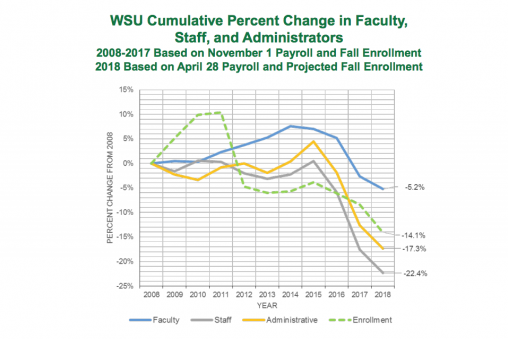
Excerpt from the Xenia Daily Gazette
Wright State University has experienced declining enrollments and budget deficits at various times during the past decade, with staff, administrators and faculty all having to tighten their belts. But in terms of lost positions, the data shows the university’s academic mission has been largely protected.
From Nov. 1, 2008, to Nov. 1, 2017, full-time equivalent enrollment declined by 14.1 percent. Over that same period, full-time equivalent staff was decreased by 22.4 percent, administrators by 17.3 percent and faculty by 5.2 percent.
Wright State’s recent enrollment declines have included sharp drops in international students, who pay higher tuition than domestic students. That put a tighter squeeze on the budget.
While every unit at Wright State shared in the reductions, the cuts were driven by the priority of protecting the university’s academic core.
Some of the staff positions eliminated or left unfilled were the result of reducing the levels of service. For example, a number of custodial positions went unfilled when service to buildings was reduced as a cost-cutting measure. Academic and other units were forced to cut or consolidate administrative support to make their budgets.
President Cheryl B. Schrader has said the fiscal 2019 budget is a challenging one.
“It continues to protect our academic core while proactively addressing revenue challenges and the need to buttress against any future unexpected or previously unbudgeted expenses,” she said. “While it is tough, it is also realistic and demonstrates a budget strategy that differs from previous years.”
The preliminary fiscal 2019 budget assumes that state support will decline 1.61 percent — a $1.4 million decrease from fiscal 2018 — and that enrollment credit hours will decline by 6.2 percent.
The budget projects revenue of $277.6 million, which includes $164.8 million from tuition and $84.6 million from the state. That compares to previous revenues of $306 million in fiscal 2017 and $287 million in fiscal 2018.
Expenses in fiscal 2019 are expected to total $274.6 million.
Objectives of the fiscal 2019 budget include maintaining the instructional and educational components of the university’s mission as the highest priority; continuing to restore reserves; providing funding for strategic investments; and continuing to emphasize a strong culture of fiscal accountability.
Under the budget, there will be no annual increases in salaries and wages. Promotion and tenure salary increases will continue.
The fiscal 2019 budget funds things not previously included such as an additional $5.5 million for medical claim expense overage experienced in 2018, $3.2 million for previously unbudgeted graduate tuition and college credit plus waivers and $1 million in strategic investments to bolster tuition revenue.
The university has already reduced some jobs this year, but the majority will come from vacant positions. Wright State began issuing reduction in force notifications for 27 filled positions in July.
Wright State currently employs more than 3,300 people. And about 200 employees cycle out of university employment in any given year.

